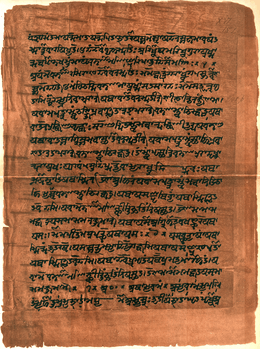Timeline of Hindu texts
Hindu scriptures are classified into two parts: shruti or śruti, meaning what has been heard and smriti, or smṛti, meaning what has been retained or remembered. The Vedas are classified under śruti.

| Part of a series on |
| Hindu scriptures and texts |
|---|
 |
| Related Hindu texts |
|
Timeline |
The following list provides a somewhat common set of reconstructed dates for the terminus ante quem of Hindu texts, by title or genre. All dates here given ought to be regarded as roughly approximate, subject to further revision, and generally as relying for their validity on highly inferential methods and standards of evidence. It is also notable that Hinduism largely followed an oral tradition to pass on knowledge, for which there is no record of historical dates; hence, the below dates are to be considered as to when written records of these texts were found, and not necessarily when they originated.
- Samhita, Brahmana layers of the Vedas
- Rigveda, 1800 – 1100 BCE[1][2]
- Samaveda, 1200 - 800 BCE[2]
- Yajurveda, 1100 - 800 BCE[2]
- Atharvaveda, 1000 - 800 BCE[2]
The early Upanishads were composed over 900 - 300 BCE.[2][3]
- Others
- Mahabharata, 400 BCE[4][5][6](Origins likely in the 8th or 9th century BCE)[5]
- Bhagavad Gita, 400 BCE[2]
- Ramayana, 400 BCE[4][7][8]
- Samkhya Sutra
- Mimamsa Sutra, 300-200 BCE[9]
- Arthashastra, 400 BCE-[10]
- Nyaya Sutra, 2nd century BCE[11]
- Vaiseshika Sutra, 2nd century BCE[12]
- Yoga Sutras of Patanjali, 100 BCE - 500 BCE[13]
- Brahma Sutra, 500 BCE[14][15]
- Puranas, 250 – 1000 CE[16]
- Shiva Sutras, 120 BCE
- Abhinavabharati, 950 - 1020 CE
- Yoga Vasistha, 750 CE [17][18]
See also
References
- Oberlies, Thomas (Die Religion des Rgveda, Wien, 1998, p. 155) gives an estimate of 1100 BCE for the youngest hymns in book 10. Estimates for a terminus post quem of the earliest hymns are more uncertain. Oberlies (p. 158) based on 'cumulative evidence' sets wide range of 1700–1100
- Flood, Gavin (1996). An Introduction to Hinduism. pp. 37-39. ISBN 0521438780.
- Sharma, Shubhra (1985), Life in the Upanishads, Abhinav Publications, ISBN 978-81-7017-202-4, pp. 17–19.
- Molloy, Michael (2008). Experiencing the World's Religions. p. 87. ISBN 9780073535647.
- Brockington, J. (1998). The Sanskrit Epics, Leiden. p. 26
- Van Buitenen; The Mahabharata Vol. 1; The Book of the Beginning. Introduction (Authorship and Date).
- Narayan, R.K. The Ramayana. Penguin Group, 2006, page xxiii: "The Indian epic, the Ramayana, dates back to 1500 BCE according to certain early scholars. Recent studies have brought it down to about the fourth century BCE."
- Chaurasia, Radhey Shyam. History of Ancient India: Earliest Times to 1000 A. D.. p. 38:"the Kernel of the Ramayana was composed before 500 B.C. while the more recent portion were not probably added till the 2nd century B.C. and later."
- Hiriyanna, M. (1995). The Essentials of Indian Philosophy. Delhi: Motilal Banarsidass. p. 130. ISBN 81-208-1330-8.
- Trautmann 1971:185 "If the Kautilīya Arthaśāstra in its present form is not so old as it pretends, the śāstra itself is certainly old, predating the dharma smritis."
Mabbett 1964 "The content of the text is consistent with authorship in about the third century, C.E., and raises some questions which must be answered if it is to be assigned to the fourth B.C.E. Against this must be set the verses naming and characterising Kautilya, and the references in later literature. What emerges is that there is no necessary incompatibility between the essential claims that Chanakya was responsible for the doctrines of the Arthaśāstra, and that the text we know is a product of the later time. These do not conflict. The work could have been written late on the basis of earlier teachings and writings. Sanskrit literature being so full of derivative, traditional and stratified material, this possibility is a priori strong. Those who favour the early date usually admit the probability of interpolations....Those who favour a later date usually admit the probability that the work draws on traditional material. The controversy is therefore spurious. It is entirely possible that the Mauryan Kautilya wrote an arthaśāstra and that a later editor rewrote his work, or compressed it, or compiled a text from the teachings of his school." - B. K. Matilal "Perception. An Essay on Classical Indian Theories of Knowledge" (Oxford University Press, 1986), p. xiv.
- Oliver Leaman, Key Concepts in Eastern Philosophy. Routledge, 1999 , page 269.
- Flood, Gavin (1996). An Introduction to Hinduism. Cambridge: Cambridge University Press. p. 96. ISBN 0-521-43878-0.
- James Lochtefeld, Brahman, The Illustrated Encyclopedia of Hinduism, Vol. 1: A–M, Rosen Publishing, ISBN 978-0823931798, page 746
- Andrew J. Nicholson (2013). Unifying Hinduism: Philosophy and Identity in Indian Intellectual History. Columbia University Press. p. 26. ISBN 978-0-231-14987-7.
- Collins, Charles Dillard (1988). The Iconography and Ritual of Śiva at Elephanta. SUNY Press. p. 36. ISBN 978-0-88706-773-0.
- Chapple, Christopher (1984). "Introduction". The Concise Yoga Vāsiṣṭha. Translated by Venkatesananda, Swami. Albany: State University of New York Press. pp. ix-x with footnote 3. ISBN 0-87395-955-8. OCLC 11044869.
- Hanneder, Jürgen; Slaje, Walter. Moksopaya Project: Introduction Archived 2005-12-28 at the Wayback Machine.
